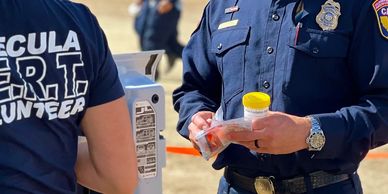Current Projects
Clean Cab Concept
Hydration and Cardiac Risk
Cancer Cohort Study

The clean cab concept has become more commonplace in structure and urban firefighting, however it has not been widely implemented on WUI/wildland fires. With support from the National Institute of Standards and Technology, the IAFF, FEMA, and CAL FIRE, we are identifying hazards inside the apparatus, and what you can do to stay safe and reduce exposure risk.
Cancer Cohort Study
Hydration and Cardiac Risk
Cancer Cohort Study
The Wildfire Conservancy has partnered with CAL FIRE, the national Fire Fighter Cancer Cohort Study, and the University of Arizona. We are leading the effort to enroll hundreds of wildland firefighters to study exposure risk and identify interventions to help reduce the risk of cancer. Find out more about the study and view short videos with important safety information for firefighters.
Hydration and Cardiac Risk
Hydration and Cardiac Risk
Decontamination and Risk Reduction
The importance of hydration cannot be overstated. The temperature of that water can have significant benefits on cardiac risk, core temperature, and occupational exposures. Follow the link below to learn more about how iced water can significant mitigate cardiac and dehydration risk, and download some materials for your own station and training programs.
Decontamination and Risk Reduction
Improving Wildland and WUI Respiratory Protection
Decontamination and Risk Reduction

Our firefighters are working in some of the most hazardous conditions imaginable, with limited protection from smoke or particulate exposure. The Conservancy has led several national efforts to evaluate firefighter exposure risk and the cultural and behavioral challenges. Follow this link to learn more about how firefighters perceive their own risk, and some of the ways we can improve acceptance, adoption, and implementation of advanced safety protocols and policies.
Dermal Exposure and PPE
Improving Wildland and WUI Respiratory Protection
Improving Wildland and WUI Respiratory Protection

Improving the health and safety of our firefighters means that we have to find novel solutions to reduce risk and exposures. Today, we are studying the risks, and evaluating new types of particulate-barrier PPE that may help reduce exposures on wildland/WUI fires. Follow the link below for updates on the projects, and some of the early recommendations on how we can keep our firefighters safe.
Improving Wildland and WUI Respiratory Protection
Improving Wildland and WUI Respiratory Protection
Improving Wildland and WUI Respiratory Protection

Our firefighters are working in smoky environments with extreme levels of hazardous, toxic, and carcinogenic compounds. Despite significant advancements through NFPA 1984, most agencies have not implemented clear protocols or policies to help reduce exposures or mandate respiratory protection. The Conservancy is working closely with CAL FIRE, CAL FIRE L2881, IAFF, CalOSHA, and NC State University to evaluate and help implement new respiratory protection. Follow the link for current updates and information.
Hose Clamp Study

One of the most basic tools in firefighting is also often the most unreliable. We are currently working with engineering students at Cal Poly San Luis Obispo to explore a new design may help improve wildland firefighting and attack effectiveness.
Advanced Cooling and Improved Air Quality
In collaboration with engineering student at Cal Poly, we are imagining new ways to keep firefighters cool, and help improve the air they breathe. There are some exciting new ideas that can significantly improve the health and wellbeing of our firefighters as they do their job.
